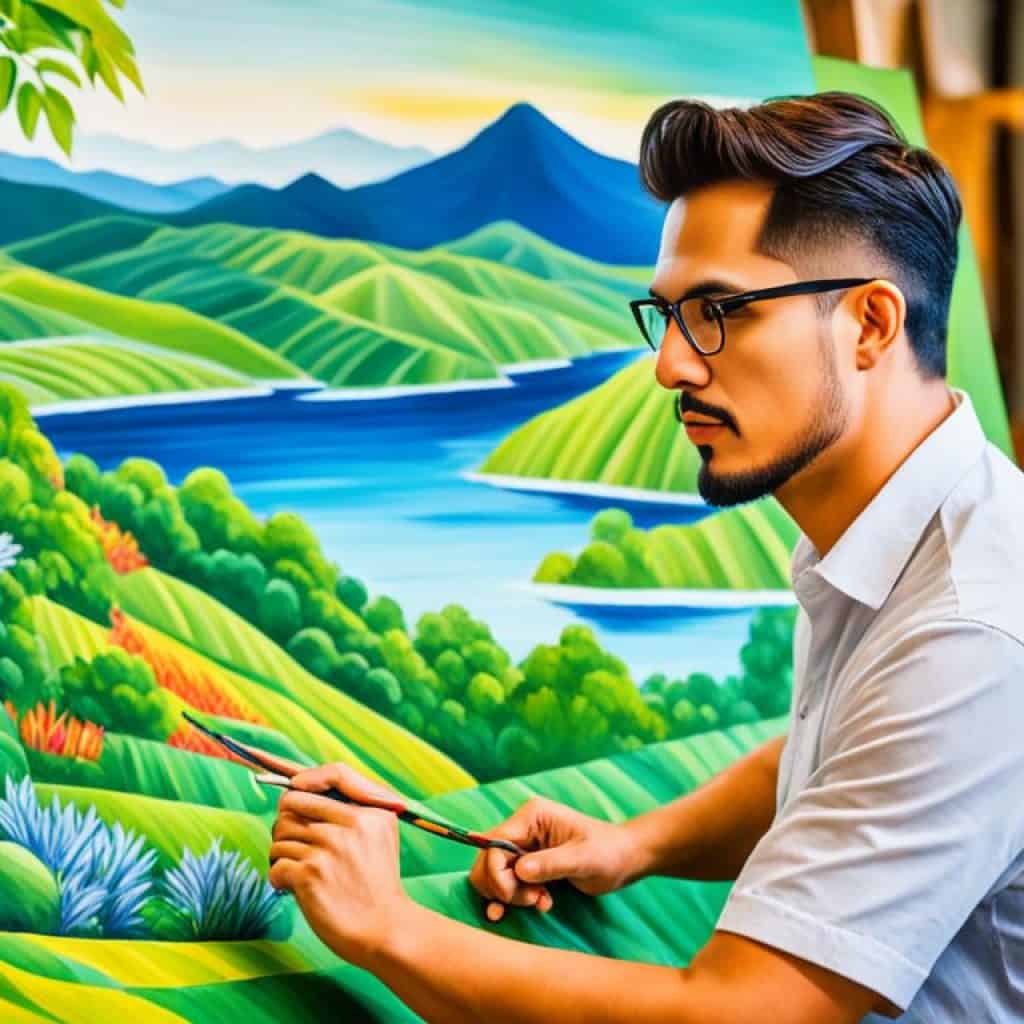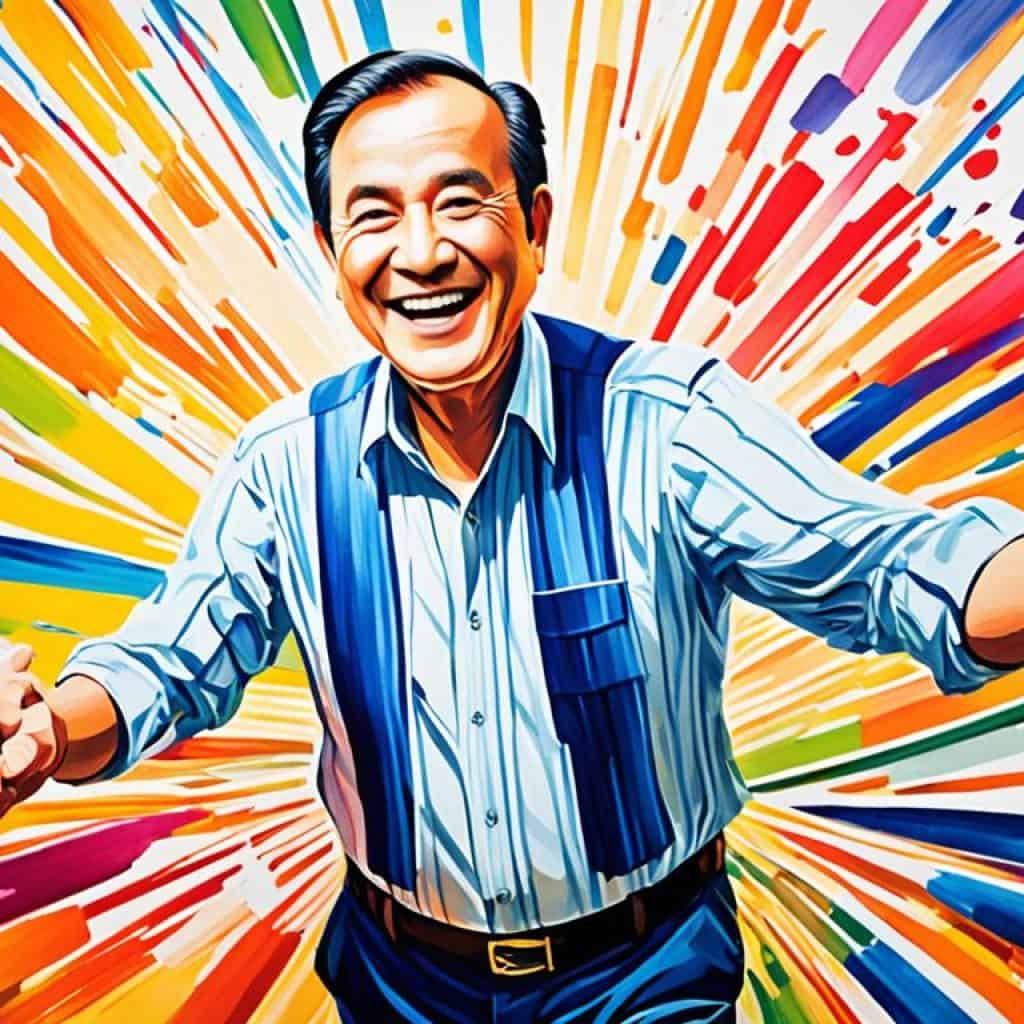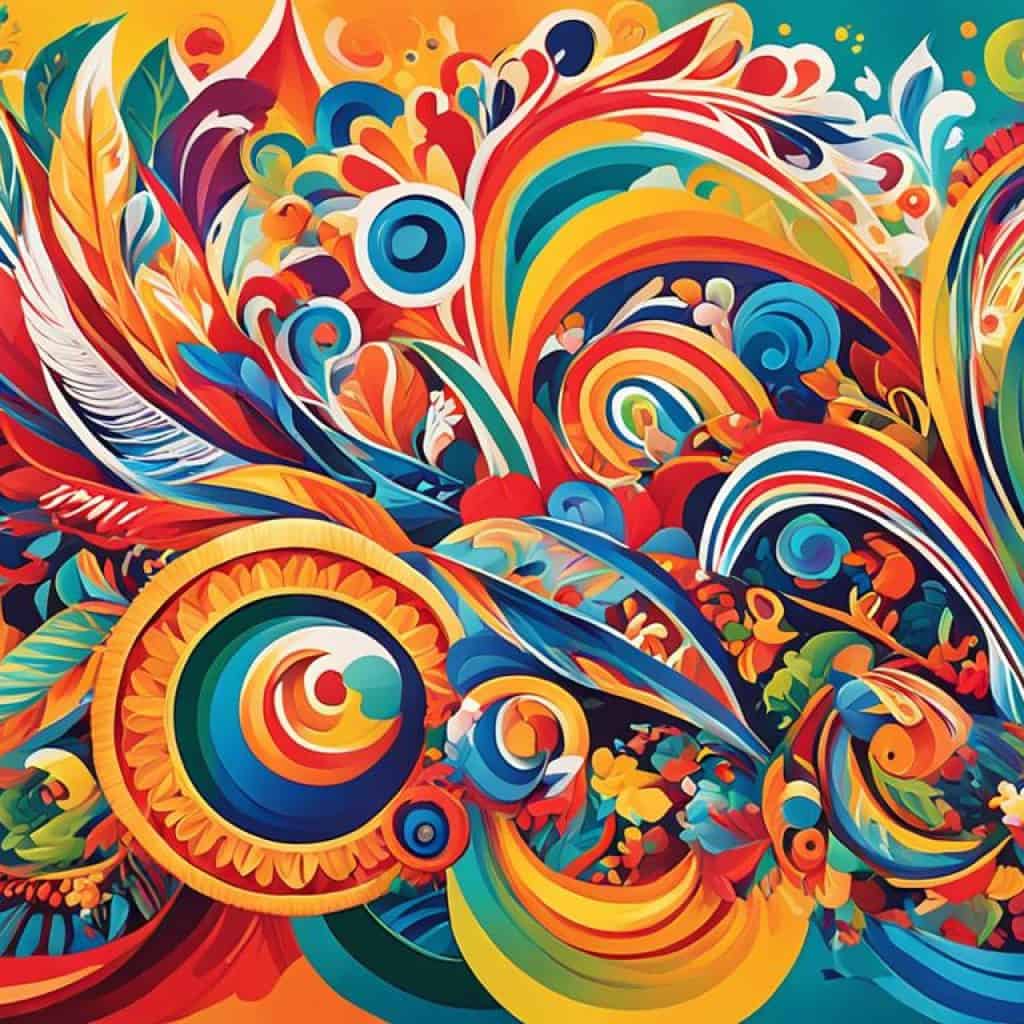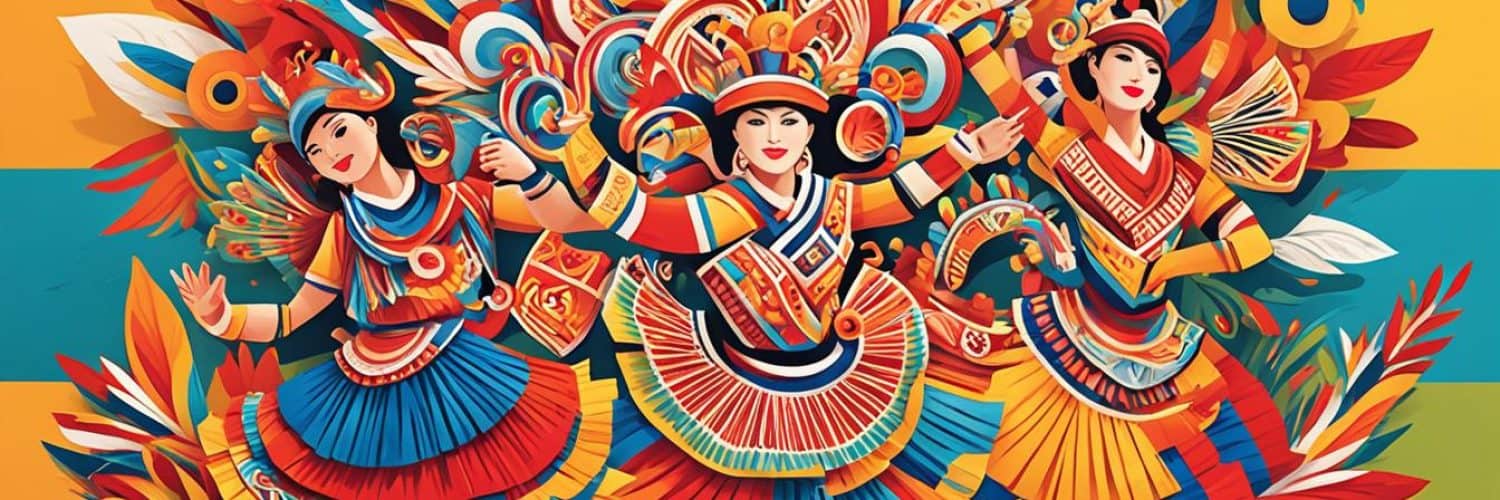Step into a world where tradition meets modernity, and cultural expression takes center stage. The Philippines, known for its breathtaking landscapes and warm hospitality, is also home to a flourishing art scene that captivates both locals and visitors alike. But what lies beneath the surface of Filipino artwork and the Philippine art scene? How do Filipino artists express their cultural heritage through their creations? Join us as we delve into the heart of the Philippines’ vibrant arts and uncover the stories behind its contemporary masterpieces.
Key Takeaways:
- The Philippine contemporary art scene melds traditional Filipino crafts with modern artistic expression.
- Filipino artists use their work to reflect and critique social issues, making a profound impact on society.
- The Philippines’ rich cultural heritage is brought to life through diverse and dynamic art styles.
- Notable Filipino artists such as Bencab, Nona Garcia, Elmer Borlongan, and Patricia Perez Eustaquio have left an indelible mark on the Philippine contemporary art scene.
- Art galleries and museums in the Philippines, such as the Metropolitan Museum of Manila and Ateneo Art Gallery, provide a platform for artists to showcase their masterpieces.
Overview of Philippine Contemporary Art
The Philippine contemporary art scene is a vibrant reflection of the country’s rich cultural tapestry. It seamlessly fuses traditional Filipino aesthetics with modern artistic expression, resulting in a diverse and dynamic art scene. Artists draw inspiration from indigenous folk arts and colonial-era influences, incorporating them into their work.
One of the notable characteristics of Philippine contemporary art is its ability to serve as a platform for social commentary and critique. Artists use their creations to shed light on pressing social issues and spark meaningful conversations. Through their art, they address topics such as politics, corruption, environment, and human rights, making valuable contributions to society.
The art scene in the Philippines is a true representation of the country’s cultural tapestry. It encompasses a wide range of styles, themes, and techniques, capturing the essence of the diverse Filipino identity. From vibrant paintings to intricate sculptures, Philippine contemporary art showcases the artistic prowess and creativity of Filipino artists.
To accompany the visual journey, the Table below provides a summary of the key elements that shape the distinctive nature of Philippine contemporary art:
| Key Elements | Description |
|---|---|
| Traditional Filipino Aesthetics | Incorporation of indigenous designs, patterns, and techniques |
| Modern Artistic Expression | Exploration of contemporary themes, mediums, and techniques |
| Indigenous Folk Arts | Inspiration drawn from traditional Philippine craftsmanship |
| Colonial-Era Influences | Reflection of historical and cultural influences from the colonial era |
| Social Commentary | Art as a means of addressing societal issues and sparking critical discussions |
| Cultural Tapestry | A representation of the diverse cultural heritage of the Philippines |
Philippine contemporary art is a powerful testament to the creativity and talent of Filipino artists. Through their work, they continue to shape the art scene in the Philippines, opening doors for new possibilities and pushing boundaries. The fusion of traditional elements with modern expression creates a unique and captivating visual experience for both local and international art enthusiasts.
Notable Philippine Contemporary Artists
In the vibrant Philippine contemporary art scene, several artists have emerged as notable figures, making significant contributions to the field. Let’s explore the works of Bencab, Nona Garcia, Elmer Borlongan, and Patricia Perez Eustaquio.
Bencab

Bencab, whose real name is Benedicto Cabrera, is a distinguished national artist known for his exceptional paintings that depict the essence of Filipino life. His works showcase the beauty and complexity of the country’s diverse culture, capturing the stories and experiences of its people. Bencab’s art celebrates the rich heritage of the Philippines while exploring themes of identity, history, and social issues.
Nona Garcia
Nona Garcia is a celebrated artist known for her captivating photorealistic paintings and installations. Her works often delve into the exploration of memory, identity, and personal histories. Nona’s attention to detail and mastery of technique create visually stunning artworks that engage viewers and provoke introspection. Through her art, she invites audiences to reflect on the intricacies of human existence.
Elmer Borlongan

Elmer Borlongan is recognized for his vivid and realistic paintings that provide glimpses into everyday Filipino life. His subjects range from ordinary people going about their daily routines to scenes depicting social and political issues. Elmer’s ability to capture emotions and portray the nuances of Filipino society has earned him accolades and admiration within the art community.
Patricia Perez Eustaquio
Patricia Perez Eustaquio is known for her multidisciplinary approach to art, using various mediums to explore themes of decay, desire, and the pursuit of beauty. Her works often challenge traditional notions of materiality and representation, inviting viewers to contemplate the transient nature of existence. Patricia’s art pushes boundaries and stimulates thought, reflecting her unique perspective and artistic vision.
These notable artists have left indelible marks on the Philippine contemporary art landscape, each contributing to the vibrant and diverse artistic expressions of the country.
Prominent Art Movements in the Philippines
The Philippine contemporary art scene has been shaped by several prominent art movements that have brought innovation, diversity, and fresh perspectives to the creative landscape. These art movements have challenged traditional norms and conventions, pushing the boundaries of artistic expression in the Philippines.
Modernism
Modernism emerged in the mid-20th century and marked a departure from traditional art forms. It introduced abstract and non-representational elements, as well as styles such as expressionism and cubism. Modernist artists sought to convey emotions and explore new ways of seeing the world. They embraced experimentation and emphasized the use of color, form, and composition.
Neo-Realism
Neo-Realism emerged in the late 20th century as a response to social and political developments in the Philippines. This art movement aimed to portray reality with a fresh perspective, often using everyday scenes and ordinary people as subjects. Neo-Realist artists sought to capture the essence of Filipino culture and society, addressing issues of identity, poverty, and social inequality.
Post-Modernism
Post-Modernism emerged as a rejection of the rigid boundaries and definitions of traditional art. It sought to challenge established norms, embracing diversity and blurring the lines between different forms of art. Post-Modernist artists often incorporated elements of popular culture, mass media, and technology into their work. They aimed to deconstruct and critique existing conventions, sparking new conversations and interpretations.
Conceptual Art
Conceptual Art prioritizes ideas and concepts over the visual components of art. It emphasizes the thought process behind the artwork and uses art as a medium for critiquing social, political, and cultural issues. Conceptual artists often use unconventional materials and techniques, focusing on the message and the intellectual engagement it provokes. They challenge viewers to question the nature and purpose of art, inviting them to think deeply and critically.
These prominent art movements have played a pivotal role in shaping the Philippine contemporary art scene, allowing artists to express themselves, challenge conventions, and offer diverse perspectives on society and culture.

Discover how these art movements have shaped the Philippine contemporary art scene. Explore the works of influential artists who have challenged traditions, sparked conversations, and left an indelible mark on the art world.
How to Appreciate Philippine Contemporary Art
Appreciating Philippine contemporary art doesn’t require expertise. Here are some steps to help you appreciate it:
- Look: Examine the artwork closely, taking note of the vibrant colors, unique shapes, intricate textures, and captivating details. Allow yourself to be visually immersed in the artwork’s beauty and intricacies.
- Think: Reflect on what the artwork is trying to convey and the emotions it evokes within you. Consider the underlying messages, themes, and symbolism portrayed by the artist. Contemplate the artwork’s significance and how it relates to your own experiences and perspectives.
- Learn: Deepen your understanding of the artist and the artwork by exploring their background, inspirations, and artistic techniques. Discover the artist’s intentions, the cultural and historical context of the artwork, and the influences that shaped its creation.
- Engage: Engage in conversations and discussions about the artwork with fellow art enthusiasts, friends, or even the artist themselves if possible. Share your interpretations and listen to diverse perspectives. Engaging in dialogue allows you to gain new insights, broaden your understanding, and enrich your overall art appreciation experience.
Prominent Art Galleries and Museums in the Philippines
The Philippines is a haven for art enthusiasts, with a wide array of prominent art galleries and museums showcasing the best of local contemporary art. These cultural institutions provide a platform for both established and emerging artists to exhibit their work, offering a glimpse into the vibrant art scene in the country.
Metropolitan Museum of Manila
The Metropolitan Museum of Manila, known as the Met, is a premier art institution that consistently hosts exhibitions featuring the works of renowned Philippine contemporary artists. With its impressive collection and diverse rotating exhibits, the Met offers a comprehensive exploration of contemporary art in the Philippines.
Cultural Center of the Philippines (CCP)
The Cultural Center of the Philippines serves not only as a performance venue but also as a space dedicated to the visual arts. The CCP features galleries that display the works of both established and up-and-coming artists, providing a dynamic platform for artistic expression. It is a hub for creativity and innovation, contributing significantly to the development of contemporary art in the Philippines.
Ateneo Art Gallery
The Ateneo Art Gallery, located within the Ateneo de Manila University campus, is a treasure trove of Philippine contemporary art. With its extensive collection and commitment to showcasing Filipino artistic talent, the gallery plays a crucial role in promoting and preserving the country’s cultural heritage. It serves as an educational resource for students and art enthusiasts, fostering a deeper appreciation for Philippine contemporary art.
Pinto Art Museum
Situated in Antipolo, the Pinto Art Museum is a unique destination that showcases a vast collection of contemporary art pieces by Filipino artists. Its picturesque setting, nestled amidst lush gardens and beautiful architecture, creates a serene ambience that complements the art on display. The museum offers visitors an immersive experience, allowing them to engage with the vibrant and diverse Philippine art scene.
A visual representation of the prominent art galleries and museums in the Philippines:
| Galleries and Museums | Description |
|---|---|
| Metropolitan Museum of Manila | A premier art institution hosting exhibitions featuring renowned Philippine contemporary artists. |
| Cultural Center of the Philippines (CCP) | A multidisciplinary venue showcasing the works of established and emerging artists. |
| Ateneo Art Gallery | A gallery within Ateneo de Manila University dedicated to Philippine contemporary art. |
| Pinto Art Museum | A museum with a vast collection of contemporary art pieces by Filipino artists. |
Impact of Philippine Contemporary Art in Society
Philippine contemporary art has a profound impact on society, influencing social issues, fostering critical thinking, preserving cultural heritage, and contributing to the economy. Artists harness the power of their creations to reflect the struggles, hopes, and experiences of society, acting as a mirror that stimulates dialogue and awareness.
Through their artworks, artists address pressing social issues, shedding light on topics such as politics, corruption, human rights, and the environment. By presenting different perspectives and challenging prevailing narratives, art encourages critical thinking, inviting viewers to question and evaluate their own beliefs and values.
Furthermore, Philippine contemporary artists play a vital role in promoting and preserving the country’s rich cultural heritage. Many artists draw inspiration from traditional Filipino art forms, incorporating them into their work and ensuring their legacy endures in the modern era. This fusion of traditional and contemporary elements not only serves as a tribute to the past but also fosters a deeper appreciation for the cultural diversity and legacy of the Philippines.
In addition to its cultural impact, Philippine contemporary art also contributes to the economy. The sale of artworks, the collection of admission fees to galleries and museums, and the growing trend of art tourism all generate economic value. These financial contributions support artists, galleries, and the wider creative ecosystem, helping to sustain and grow the vibrant Philippine contemporary art scene.
Art, in all its diverse forms, has the power to inspire, provoke thought, and spark change. In the context of the Philippines, contemporary art serves as a catalyst for social progress, critical engagement, cultural preservation, and economic development. Its impact resonates beyond the boundaries of the art world, permeating society and enriching the lives of individuals across the country.
Future of Philippine Contemporary Art
The future of Philippine contemporary art holds great promise as artists embrace new possibilities and continue to push the boundaries of artistic expression. The art scene in the Philippines is evolving and adapting to the digital age, embracing the potential of digital art as technology advances.
One of the exciting developments in the future of Philippine contemporary art is the integration of digital art into traditional artistic practices. Artists are exploring the use of digital tools and techniques to create innovative works that blend the physical and virtual worlds. This embrace of digital art opens up new avenues for creativity and experimentation, pushing the boundaries of what art can be.
At the same time, artists are also committed to embracing and celebrating their cultural traditions. They recognize the importance of preserving and honoring their heritage, and they incorporate elements of indigenous art forms and cultural symbolism into their work. This fusion of old and new not only pays homage to the country’s rich cultural tapestry but also adds unique depth and meaning to contemporary art in the Philippines.
Furthermore, artists are constantly exploring new mediums and techniques to expand the possibilities of art. From traditional painting and sculpture to installations, video art, and performance art, artists are pushing the boundaries of what constitutes art and how it can be experienced. This experimentation with new mediums encourages viewers to engage with art in new ways and challenges conventional notions of artistic expression.
The future of Philippine contemporary art also involves evolving global recognition. As international interest in the art scene grows, Filipino artists are gaining increased exposure and recognition on the global stage. This global recognition not only provides opportunities for artists to exhibit their work internationally but also contributes to the overall growth and development of the art scene in the Philippines.
Emerging Trends in Philippine Contemporary Art
| Trend | Description |
|---|---|
| Embracing Digital Art | Artists incorporating digital tools and techniques into their work |
| Embracing Cultural Traditions | Incorporating elements of indigenous art forms and cultural symbolism |
| Exploring New Mediums | Experimenting with unconventional mediums and techniques |
| Evolving Global Recognition | Increasing international exposure and recognition |
The future of Philippine contemporary art is an exciting journey of exploration, innovation, and cultural celebration. As artists embrace digital art, cultural traditions, and new mediums, the art scene in the Philippines will continue to evolve and flourish, gaining recognition both locally and globally. With each new artwork, artists shape the future of Philippine contemporary art, inspiring and challenging viewers to see the world from fresh and thought-provoking perspectives.
Conclusion
The Philippine contemporary art scene is a vibrant reflection of the country’s rich cultural tapestry. It is a fusion of traditional Filipino aesthetics and modern artistic expression, creating a dynamic mix of artistic styles and techniques. Filipino artists use their work to express social commentary and critique, addressing relevant issues that impact society, such as politics, corruption, environment, and human rights.
The art scene in the Philippines is diverse and ever-evolving, with no single defining style. Notable Filipino artists, such as Bencab, Nona Garcia, Elmer Borlongan, and Patricia Perez Eustaquio, have made significant contributions to the art scene, pushing boundaries and sparking meaningful conversations.
The future of Philippine contemporary art looks promising, with artists embracing digital art, exploring cultural traditions, and experimenting with new mediums. As technology advances, artists are incorporating digital elements into their work, while still celebrating and preserving traditional Filipino crafts. This dynamic approach ensures that the art scene continues to evolve and gain global recognition.
Philippine contemporary art holds a vital place in the global art scene, representing the cultural heritage and expression of the Filipino people. Its fusion of old and new, rooted in traditional Filipino aesthetics and contemporary artistic expression, is a testament to the country’s rich cultural tapestry. With its diverse styles, themes, and techniques, Philippine contemporary art captivates and engages audiences, forging connections and fostering meaningful discussions about social issues and cultural identity.
FAQ
What is Philippine contemporary art?
Philippine contemporary art is a fusion of traditional Filipino aesthetics and modern artistic expression. It incorporates elements from indigenous folk arts and colonial-era influences, and artists use their work to express social commentary and critique on issues such as politics, corruption, environment, and human rights.
Who are some notable Philippine contemporary artists?
Some notable Philippine contemporary artists include Bencab, Nona Garcia, Elmer Borlongan, and Patricia Perez Eustaquio. Bencab is known for his paintings depicting Filipino life, while Nona Garcia explores memory and personal histories. Elmer Borlongan provides a glimpse into everyday Filipino life through his realistic paintings, and Patricia Perez Eustaquio uses various mediums to explore themes of decay and desire.
What are some prominent art movements in the Philippines?
Some prominent art movements in the Philippines include Modernism, Neo-Realism, Post-Modernism, and Conceptual Art. Modernism introduced abstraction and cubism, Neo-Realism focused on portraying reality from a different perspective, Post-Modernism challenged traditional art norms, and Conceptual Art prioritized ideas over visual components.
How can I appreciate Philippine contemporary art?
To appreciate Philippine contemporary art, you can look at the artwork and notice its colors, shapes, textures, and details. Think about what the artwork is trying to say and how it makes you feel. Learn more about the artist, the context of the artwork, and the techniques used. Engage with others to discuss the artwork, gaining new perspectives and enriching your art appreciation experience.
What are some prominent art galleries and museums in the Philippines?
Some prominent art galleries and museums in the Philippines include the Metropolitan Museum of Manila (Met), the Cultural Center of the Philippines (CCP), the Ateneo Art Gallery, and the Pinto Art Museum. These venues showcase the best of local contemporary art and offer opportunities to engage with the works of renowned Philippine artists.
What is the impact of Philippine contemporary art in society?
Philippine contemporary art has a significant impact on society. Artists use their work to reflect social issues, encourage critical thinking, and provide a mirror to society’s struggles, hopes, and experiences. They also play a role in promoting and preserving the country’s cultural heritage by incorporating traditional Filipino art forms into their work. Additionally, art contributes to the economy through the sale of artworks, admission fees to galleries and museums, and art tourism.
What does the future hold for Philippine contemporary art?
The future of Philippine contemporary art is dynamic and promising. Artists are embracing digital art and exploring its potential as technology advances. They continue to integrate and create a seamless fusion of old and new, embracing their cultural traditions while pushing boundaries. Artists are also experimenting with new mediums, pushing the boundaries of what art can be and how it can be experienced. As Philippine contemporary art gains recognition on the global stage, its future looks bright, with evolving trends and increasing global recognition.


















Add comment